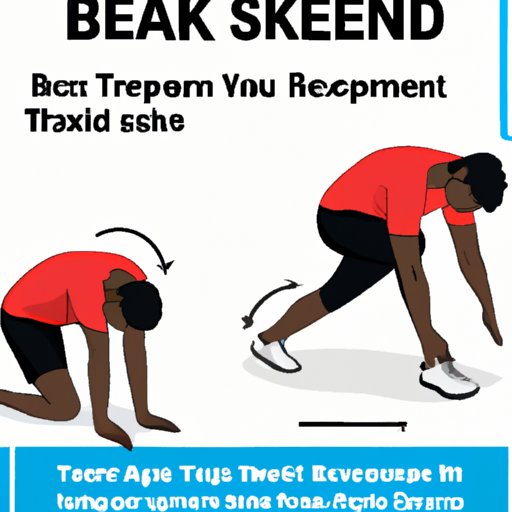Introduction
Stretching is an important part of any workout routine. It helps to warm up your muscles and prepare them for exercise, reducing the risk of injury and improving overall performance. But should you stretch before or after a workout? And is it essential to stretch every time you exercise? In this article, we’ll explore the science behind pre-workout stretching, the risks of not stretching, and provide some tips on how to get the most out of your stretches.
How to Stretch Before Starting a Workout
Before getting into the specifics of when to stretch, let’s talk about how to do it. First, start with dynamic stretches, which involve movement and can help to increase your heart rate and body temperature. Examples of dynamic stretches include arm circles, leg swings, and side lunges. Once you’ve finished your dynamic stretches, move on to static stretches, which involve holding a position for a few seconds. Some good static stretches to try include hamstring stretches, quadriceps stretches, and calf stretches.
It’s important to use proper technique when stretching. Make sure to move slowly and deliberately, and never force yourself into a stretch beyond what feels comfortable. If a stretch feels too intense, back off until you can relax into it. Hold each stretch for 15-30 seconds, and repeat two to four times on each side.
The Science Behind Pre-Workout Stretching
So what does the science say about pre-workout stretching? According to a review of the literature published in Sports Medicine, there is evidence that stretching can improve flexibility, reduce muscle soreness, and enhance range of motion.1 Another study found that stretching prior to exercise can reduce the risk of musculoskeletal injury.2 Additionally, stretching before a workout has been shown to have positive physiological effects, such as increased blood flow to the muscles and improved posture.
Should You Stretch Before or After a Workout?
Now that we’ve discussed the benefits of stretching, let’s talk about when to do it. Generally speaking, it’s best to stretch after a workout when your muscles are warm and more pliable. However, if you’re doing an activity that requires a lot of flexibility (such as yoga or gymnastics), it’s a good idea to stretch beforehand. Additionally, if you’re feeling particularly tight or stiff, you may want to do a few light stretches before starting your workout.
It’s also important to note that stretching after a workout can be just as beneficial as stretching before. A study published in the Journal of Strength and Conditioning Research found that post-workout stretching can improve flexibility and reduce muscle soreness.3 So if you’re short on time, don’t worry — you can still reap the benefits of stretching by fitting it into your cooldown routine.
Is It Necessary to Stretch Before Every Workout?
The answer to this question depends on your goals and level of fitness. If you’re looking to improve your flexibility, then stretching before and after each workout is probably a good idea. However, if you’re doing a low-intensity activity or one that doesn’t require a lot of range of motion (such as running or weight lifting), then stretching beforehand may not be necessary.
If you decide that pre-workout stretching isn’t for you, there are other ways to reduce your risk of injury. For example, taking a few minutes to warm up with light cardio can help to increase your heart rate and body temperature, making your muscles more pliable and less prone to strain.
What Are the Risks of Not Stretching Before Exercising?
Skipping pre-workout stretching comes with its own set of risks. Without stretching, your muscles may not be adequately prepared for the demands of exercise, leaving you vulnerable to injury. Additionally, without stretching, your range of motion may be limited, making it difficult to perform exercises correctly and safely.
That being said, there are strategies you can use to minimize injury risk without stretching. For example, it’s important to always warm up with light cardio before starting a workout. Additionally, focus on form and technique rather than speed or intensity. Finally, make sure to take breaks throughout your workout and listen to your body — if something feels wrong, stop and take a break.
Conclusion
Stretching before a workout can be a great way to reduce injury risk and improve performance. It helps to warm up your muscles and increase range of motion, making it easier to perform exercises correctly. That being said, stretching isn’t essential for every workout — if you’re doing low-intensity exercise or an activity that doesn’t require a lot of flexibility, then you may be able to skip it. Ultimately, it’s important to listen to your body and find what works best for you.
(Note: Is this article not meeting your expectations? Do you have knowledge or insights to share? Unlock new opportunities and expand your reach by joining our authors team. Click Registration to join us and share your expertise with our readers.)
